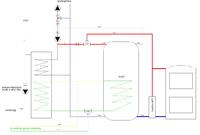Hello, I have a question, can anyone help me in choosing the size of the furnace and the heat buffer? we are building a house with an area 114 m2 of usable space + garage about 32 m2, 4 people, simple, compact body. We want a solid fuel stove - coal / wood, underfloor heating on the ground floor and the attic, possibly a heater in the bathroom and maybe in the corridor near the stairs. To reduce the frequency of servicing the furnace, we want to install a heat buffer, maybe 1000l?. In addition, we would like solar panels to heat the water in the summer period, or to support heating in the winter period. I want fairly quick and professional advice, we will be laying the plumbing soon and we want to buy the entire installation this year.
I have seen a lot of connection diagrams and I do not know what to use when:
in summer he wants to heat domestic hot water
in winter, he wants to heat the apartment first and then load the buffer - how to distinguish it?
I understand that the solar panels are included in the coils at the bottom of the buffer - how does the utility water heat up?
I will be obliged to help in this topic - recommendation of producers, etc.
Monika
I have seen a lot of connection diagrams and I do not know what to use when:
in summer he wants to heat domestic hot water
in winter, he wants to heat the apartment first and then load the buffer - how to distinguish it?
I understand that the solar panels are included in the coils at the bottom of the buffer - how does the utility water heat up?
I will be obliged to help in this topic - recommendation of producers, etc.
Monika





